 Henri de Toulouse-Lautrec photographed by Paul Sescau around 1894
Henri de Toulouse-Lautrec photographed by Paul Sescau around 1894
Who was Henri de Toulouse-Lautrec?
Henri's mother, Adèle Tapié de Céleyran, married Alphonse, Comte de Toulouse-Lautrec, who was Henri's first cousin. Alphonse was a great rider who, like all members of his family, loved hunting and horses. Henri's mother took care of him after his parents separated. He grew up between the Château du Bosc, which is in Rouergue, north of Albi, and the Château de Céleyran, which is near Narbonne.
In 1872, the Countess and the young Henri moved to Paris, first rue Boissy-d'Anglas, then to Neuilly. Henri was educated at the Lycée Fontanes, which later became the Lycée Condorcet. He left high school in 1875 because he was ill. The kid gets the top prizes because he's smart and works hard. Henri met Maurice Joyant, who lived from 1864 to 1930, when he was at school. Joyant became Henri's best friend, his dealer, his first biographer and one of the people who created the Toulouse-Lautrec museum in Albi.
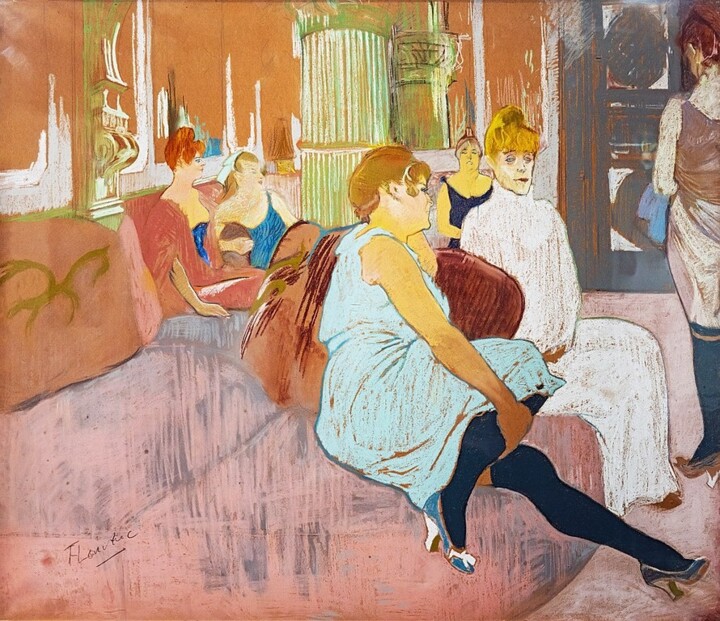 Henri de Toulouse-Lautrec, Salon Rue des Moulins (1894), pastel, Albi, Toulouse-Lautrec museum
Henri de Toulouse-Lautrec, Salon Rue des Moulins (1894), pastel, Albi, Toulouse-Lautrec museum
In 1874, Henri was told that he was suffering from pycnodysostosis, a genetic disease which could have been caused by the fact that his parents were related. This disease slows down and weakens bone growth. At only 13, he broke his left femur in a bad fall, then his right leg in another accident. His illness made him take longer to recover, and he retained his odd appearance and short stature of 1m52.
Henri has been drawing since he was a child, when his uncle taught him. The grandmother said that all the men in the family were painters because they had "pencil disease". While recovering, he turned to brushes and began dreaming of becoming an artist. He painted a magnificent picture of a horse when he was only fifteen. Proportion problems show how the artist, who is sick and has to look at things from a low angle, sees things.
 Henri de Toulouse-Lautrec, At the Moulin-Rouge (1892), oil on canvas (123 × 140.5 cm ), Chicago, Art Institute of Chicago.
Henri de Toulouse-Lautrec, At the Moulin-Rouge (1892), oil on canvas (123 × 140.5 cm ), Chicago, Art Institute of Chicago.
In 1881, he failed the baccalaureate in Paris, but in October of the same year, he passed it in Toulouse. He then made the decision to become an artist. He ended up obtaining the agreement of his mother with the help of his uncle Charles and a friend of his father, the animal painter René Princeteau, as well as the two brothers Arthur and Charles du Passage, who were draftsmen and sculptors. Back in Paris, he studied painting with René Princeteau in his studio at 233, rue du Faubourg-Saint-Honoré. In April 1882, he entered the studio of Léon Bonnat, then in November 1882, in the studio of Fernand Cormon, where he remained until 1886. He frequented Vincent van Gogh, Émile Bernard, Louis Anquetin and Adolphe Albert, a soldier who wanted to become a painter.
Since 1884, when he moved to 5 rue Tourlaque then to 19 bis, rue Fontaine, he has lived in the Parisian district of Montmartre, where he is known as "the soul of Montmartre". His paintings show life at the Moulin-Rouge and other cabarets and theaters in Montmartre and Paris. He painted Aristide Bruant, but he also painted scenes of prostitution in Paris. To do this, he went to brothels, where he may have contracted syphilis. In particular, he had a room at La Fleur blanche. Jane Avril, singer Yvette Guilbert, and Louise Weber, who was known as La Goulue and brought the cancan from England to France, are three of the famous women he played. The Italian model Agostina Segatori ran the Café du Tambourin, where he often went. In 1887, he painted the Portrait of Vincent van Gogh there (Amsterdam, Van Gogh Museum). Suzanne Valadon, who was one of his models and perhaps his mistress, took painting lessons with Toulouse-Lautrec and was encouraged by him in her work.
 Henri de Toulouse-Lautrec, Rousse (La Toilette) (1889), oil on canvas (45 × 54 cm), Musée d'Orsay (Paris, France)
Henri de Toulouse-Lautrec, Rousse (La Toilette) (1889), oil on canvas (45 × 54 cm), Musée d'Orsay (Paris, France)
He was an alcoholic for most of his adult life, and he liked to mix his daily absinthe with cognac, which was against the rules at the time. Specifically, he used a hollow cane that hid a long flask full of alcohol by unscrewing the knob and putting a stemmed glass inside.
In March 1899, his mother placed him in a retirement home in Neuilly, la folie Saint-James. She thus helps him to stop drinking and to face the general paralysis caused by his syphilis. René Semelaigne, grand-nephew and apologist of Philippe Pinel, a believer in extraterrestrials, runs the private clinic. It offers all the most modern techniques, such as hydrotherapy, developed by Jean-Martin Charcot and developed by Paul Sollier. During these two months, he drew and painted a famous picture of "his guardian" between the banks of the Seine and the Bois de Boulogne.
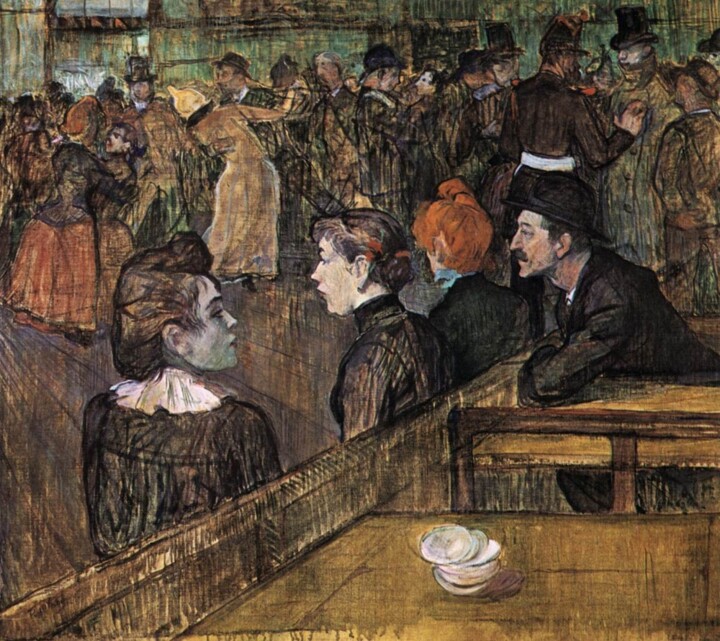
Henri de Toulouse-Lautrec, Au Moulin de la Galette (1889), oil on canvas (88.9 × 101.3 cm), Chicago, Art Institute of Chicago
In March 1901, he suffered a stroke which weakened his legs and put him in a wheelchair. On August 15, 1901, he had a stroke at Taussat which rendered him unable to move one side of his body. He was taken to the Château de Malromé by his mother, where he died on September 9, 1901. He was buried in the Verdelais cemetery (Gironde), which is not far from Malromé. "I knew dad you wouldn't miss the hallali," he reportedly said as his last words, poking fun at how his father liked to hunt. The funny thing is that this great drinker is buried in the town of Verdelais (glass of milk).
When Henri Toulouse-Lautrec died, his family wished to donate his works to a city so that it would open a museum to present his work. But Paris and Toulouse will say no because of the painter's bad reputation and the fact that he does not paint like other artists. Albi, where he was born, is the only city that agrees to take the money. In 1905, the works were exhibited at the Palais de la Berbie, which was once the bishopric and which is next to the Sainte-Cécile cathedral.
The Works of Toulouse Lautrec
He worked as an artist for Le Figaro and Le Chat Perché to earn a living (illustrations for children). He was a great poster artist and lithographer, and his works are a wonderful testimony to the bohemian life of late 19th century Paris. Living in Montmartre, where he used to frequent brothels and cabarets, he shows how people live at the Moulin Rouge and in the brothels and theaters of Montmartre.
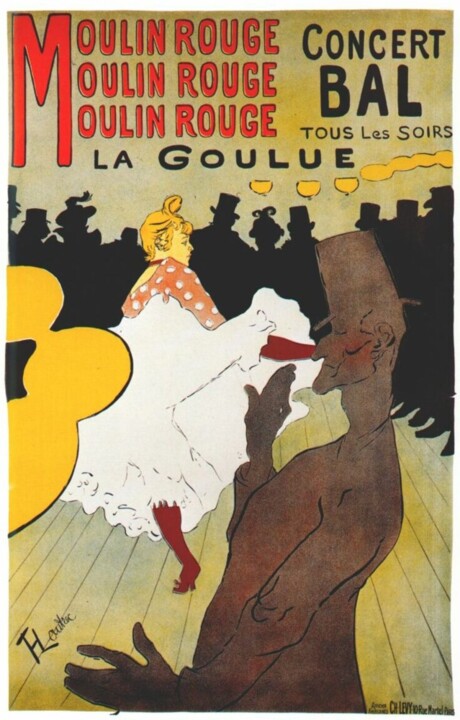
Henri Toulouse-Lautrec defines a character's personality with a quick, sharp stroke that shows movement or pose. With all his graphic bravado, his advertising posters started a street art trend that caused quite a stir. Between 1892 and 1899, Toulouse-Lautrec made more than 300 lithographs. These works are influenced by Japanese prints. He enjoys studying mores in commonplaces (theater, circus, etc.) and women's sexuality. But he also gave free rein to his stylistic genius, which brought him closer to those who created Art Nouveau.
Toulouse-Lautrec was very fond of the circus. This environment reminds him that his family does not follow the rules. He also became interested in these shows because of the way the performers' bodies moved, the way they were athletic, and the way the animals held themselves. He is also interested in the circus world because he has ties to the ancient circus, where wounded and tortured bodies were used as entertainment. But Toulouse-Lautrec doesn't want people to get used to seeing circus performers. "The show should be simple, elegant and happy".

Thus, around the mid-1880s, Toulouse-Lautrec began a lifelong relationship with the bohemian culture of Montmartre. This area of Paris, with its cafes, cabarets, artists, really interested him and gave him his first taste of fame. He mainly painted famous artists such as Aristide Bruant, Jane Avril, Loie Fuller, May Belfort, May Milton, Valentin le Désossé, Louise Weber (known as "la Gloutonne"), and clowns such as Cha-U-Kao and Chocolat.
In 1884, Toulouse-Lautrec met Bruant, a singer and composer who ran a cabaret called Le Mirliton. As Bruant liked his work, he asked Toulouse-Lautrec to draw images for his songs and offered the Mirliton as an exhibition space for Toulouse-Lautrec. Thanks to this and the fact that his drawings were printed in the magazine Mirliton de Bruant, he became known in Montmartre and began to receive requests for work.
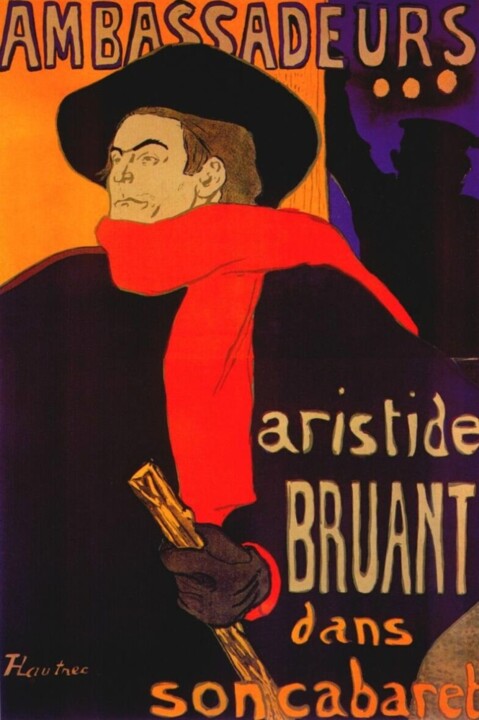
Toulouse-Lautrec tried to show the movement of the figure using entirely new means. For example, Edgar Degas, who lived at the same time as him and whose work, as well as Japanese prints, had a great impact on him, showed movement by carefully drawing the anatomy of several closely grouped figures, in trying to show only one figure at different times. On the other hand, Toulouse-Lautrec used line and color in a free manner that gave the impression of movement. Lines are no longer limited to what is anatomically correct; the colors are vivid and collide to create a thrilling rhythm; and the rules of perspective are transgressed to place the characters in a dynamic and unstable relationship with their environment. Toulouse-Lautrec often arranged his figures so that one could not see their legs. People thought this trait was the artist's response to his own wasting legs, but this treatment was actually getting rid of a specific movement in order to use the essence of the movement instead. The result is an art full of life and energy, whose formal abstraction and overall two-dimensionality announce the rise of Fauvism and Cubism during the first decade of the 20th century.
His posters also showed how unique Toulouse-Lautrec was. Toulouse-Lautrec's poster, Moulin Rouge-La Goulue, was made in 1891. It was a rejection of the idea of high art, which was usually done in oil on canvas. This poster brought Toulouse-Lautrec more and more attention. “My poster is on the walls of Paris today,” said the artist proudly. It is one of the 30 works he produced in the 10 years before his death. With posters, Toulouse-Lautrec was no longer limited by the constraints of easel painting and could make a greater impact with his art. They add to the success he enjoyed the previous year when his works were presented at the avant-garde Exposition des XX (les Vingt) in Brussels and at the Salon des Indépendants in Paris.
 Henri de Toulouse-Lautrec, In bed (1893), oil on canvas (54 × 70.5 cm), Paris, Musée d'Orsay
Henri de Toulouse-Lautrec, In bed (1893), oil on canvas (54 × 70.5 cm), Paris, Musée d'Orsay
The most important aspect of Toulouse-Lautrec is that he was able to go beyond a simple representation of reality and deeply understand the way his subjects thought and felt. After 1892, he discovered that lithography was a good way to achieve this goal. During the last ten years of his life, he produced more than 300 lithographs, including an album of 11 prints entitled Le Café Concert (1893), 16 lithographs of the performer Yvette Guilbert (1894), and 22 illustrations for Les Histoires naturelles. by Jules Renard (1899). But none of these works are as important as Elles, an 1896 series that shows life in a brothel in a sensitive way. Toulouse-Lautrec spent a lot of time observing how prostitutes and their clients moved and acted. The resulting 11 works show that these people are real people with some of the same strengths and many of the same weaknesses as other members of society. A masterpiece of the genre is Au salon de la rue des Moulins (At the Salon). People feel sorry for the women in this painting because they are alone and isolated, which the young Toulouse-Lautrec knew well. Au Salon is an excellent example of what he meant when he said he wanted to "represent the true and not the ideal". In this painting, the truth is not in showing all the details, but in capturing the essence of a subject in a few brush strokes.
Even if Toulouse-Lautrec had a short life and spent a lot of time in "debauchery", he left behind him an immense body of work: 737 paintings, 275 watercolors, 369 lithographs and more than 5000 drawings.
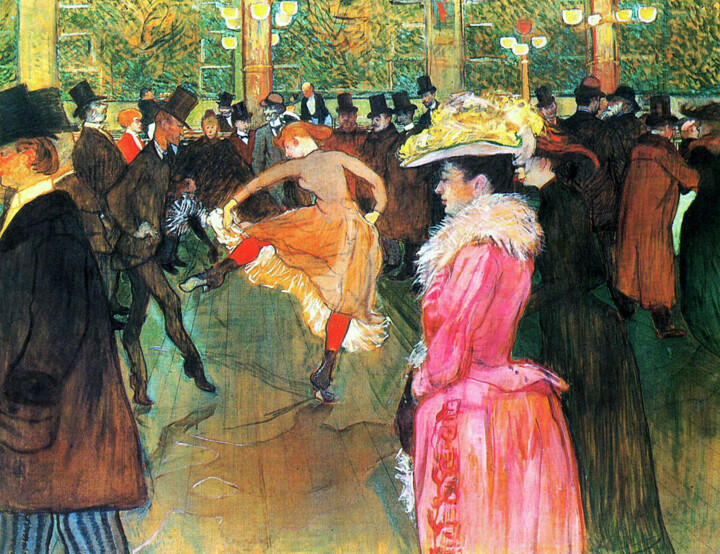 Henri de Toulouse-Lautrec, Dance at the Moulin-Rouge (1890), oil on canvas (100.5 × 150 cm), Philadelphia, Philadelphia Museum of Art
Henri de Toulouse-Lautrec, Dance at the Moulin-Rouge (1890), oil on canvas (100.5 × 150 cm), Philadelphia, Philadelphia Museum of Art
Tributes in popular culture
Henri de Toulouse-Lautrec remained famous even after his death, due to the problems he encountered and the number of works he produced. This is why we see nods to the artist in many popular works, like movies. The best known are probably the film The Aristocats (1970), in which a kitten is named "Toulouse" in his honor, and the film Moulin Rouge! (2001), in which John Leguizamo plays a funny and charming Toulouse-Lautrec.
Many artists have been influenced by Henri de Toulouse-Lautrec, his work, his personality and, of course, his wildlife. He is the main character in the series of five comics by Gradimir Smudja entitled "Le Cabaret des muses" (published by Delcourt).
Quotes from the artist Toulouse-Lautrec
“Painting is like shit; it feels, it cannot be explained. ”
"Fall is winter's spring."
"Pencils are not wood and lead, it's thought through the knuckles."
"Love is when you feel like being wanted."
"When we say we don't give a damn about something, it's because we don't give a damn."
“Always and everywhere ugliness has its accents of beauty. It's exciting to discover them where no one sees them. ”
“I will drink milk when the cows are grazing grapes. ”

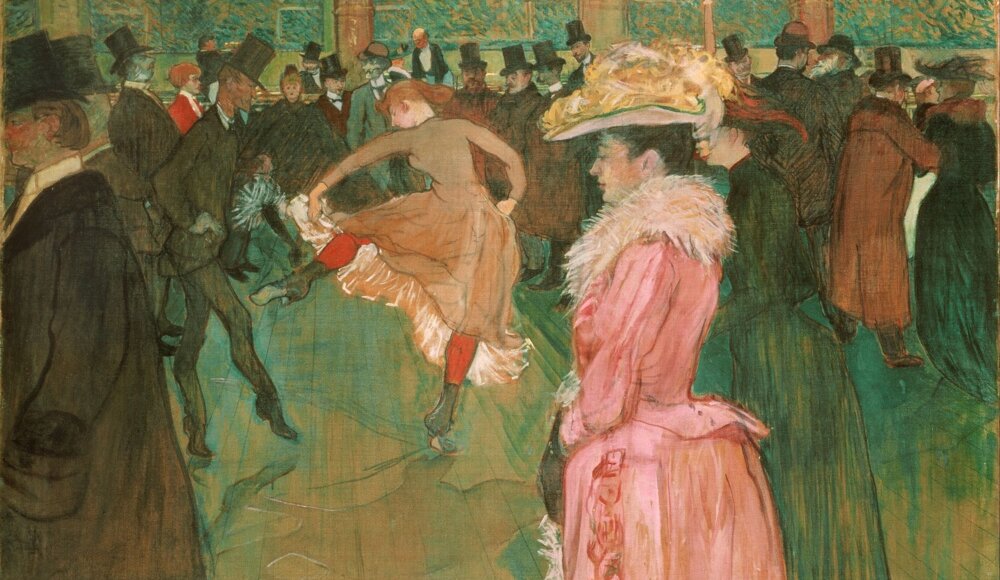
 Selena Mattei
Selena Mattei





